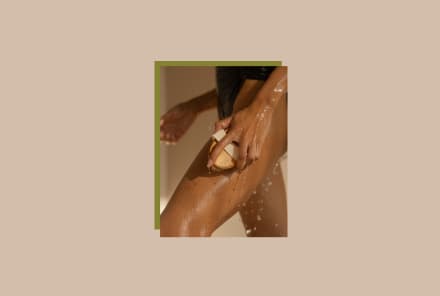Advertisement
A Plastic Surgeon Shares His Favorite Noninvasive Skin Treatment For Beginners


So you're interested in leveling up your skin care routine with a professional-grade treatment. Allow holistic plastic surgeon Anthony Youn, M.D., to be your trusted guide!
Youn, you see, has a goal of keeping patients out of the operating room, recommending you exhaust all noninvasive options (both at home and in-office) before going under the knife. These gentler methods are more powerful than you think—especially with consistency.
Now there are tons of options out there to promote skin longevity, all ranging in price points, downtime, and commitment level. Where—oh, where—should one start? Well, if you're a beginner, Youn recommends dabbling in red light therapy. Here's why he says everyone (novices and pros alike) should take part.
Why Youn recommends red light therapy
A little refresher: Red light therapy involves exposing the skin to red and near-infrared light between the wavelengths of 660 nm and 890 nm. It works via a process called photobiomodulation, which has been shown to impact cell mitochondria1 and improve the health of the skin2.
"Red light basically contributes energy to the mitochondria in your cells," Youn explains on the mindbodygreen podcast. "It causes those mitochondria to create more ATP, or more energy, to [help] those cells function in a more efficient and youthful manner." Young, spry skin cells are better at producing collagen, which leads to firmer, plump skin, as a result.
He references a "split face" study3 where researchers treated one side of the face with red light and the other with a placebo light. After treating the face twice a week for four weeks, they found a significant improvement in wrinkles, elasticity, and hydration. "They found that the collagen was thicker in the side that was treated with a red light therapy device," Youn adds, even after just a month of commitment.
Given these collagen-promoting benefits, it's no surprise that many estheticians include at least a few minutes of red light therapy in their facial services. But consistency is key, stresses Youn, and you'll see better results with regular at-home use.
"The best thing about it is you can do it in the comfort of your own home," he adds. It also fits seamlessly into any skin care routine and has zero downtime. Because of these beginner-friendly benefits, "That would be the place I would start," Youn says.
From there, you can begin to dabble in other collagen-promoting treatments that may require some extra prep and aftercare—think microneedling, lasers, etc.
How to choose a device
There are a few factors to consider when choosing an at-home red light device. First, the form: You could snag a handheld device, a face mask, a tabletop stand, or you can slip into a full-on LED bed (the latter is definitely a hefty investment, but some people do purchase at-home beds!).
Consider which type of tool you're likely to use most consistently: Do you prefer a hands-free face mask or sphere so you can multitask? Or a handheld wand that comes with other attachments (like microcurrent)? It's all up to personal preference, and there's no one design that reigns supreme—the best option is the one you'll use most frequently.
No matter which one you choose, though, you'll want to confirm its quality. Red light devices have become super buzzy over the past few years, which unfortunately means you can find a lot of knockoffs on the market. And a subpar red light device just won't deliver any skin benefits; some experts even say you'd be better off using Christmas lights.
So how do you ensure you have the highest-quality tool? Consider these signs below:
- The device has been FDA-cleared.
- They've performed clinical studies.
- The website prioritizes education.
- They're expert backed by scientists, dermatologists, or estheticians.
If your tool ticks all these boxes, it's safe to say you have a premium device on your hands. Just know that these vetted devices do often come with a higher price tag—all the more reason to ensure you have a high-quality option before making the splurge.
That said, you don't have to do the grunt work alone: Personal reviews and expert-backed recommendations can certainly help inform your search. We have a helpful list of the best LED devices here, with all the details you need to know (plus a few standout options to shop immediately below).
The takeaway
Red light therapy has benefits for everyone, whether you're just dipping your toes into noninvasive skin treatments or are well-versed in the menu of options. If you are a beginner, though, it's one of the easiest avenues to try, given it has profound, research-backed effects with zero downtime. And for those ready to level up? Youn explains how to approach your next step here.
Watch Next
Enjoy some of our favorite clips from classes
Enjoy some of our favorite clips from classes
What Is Meditation?
Mindfulness/Spirituality | Light Watkins
Box Breathing
Mindfulness/Spirituality | Gwen Dittmar
What Breathwork Can Address
Mindfulness/Spirituality | Gwen Dittmar
The 8 Limbs of Yoga - What is Asana?
Yoga | Caley Alyssa
Two Standing Postures to Open Up Tight Hips
Yoga | Caley Alyssa
How Plants Can Optimize Athletic Performance
Nutrition | Rich Roll
What to Eat Before a Workout
Nutrition | Rich Roll
How Ayurveda Helps Us Navigate Modern Life
Nutrition | Sahara Rose
Messages About Love & Relationships
Love & Relationships | Esther Perel
Love Languages
Love & Relationships | Esther Perel




















